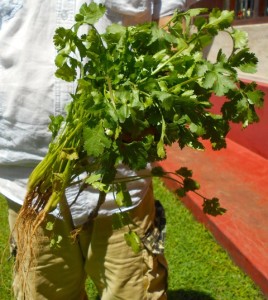SRI LANKA ROUNDABOUT (Number 24) – Bunch of coriander leaves
by · Published · Updated
A weekly look at Sri Lanka for Jetwing by Royston Ellis
Welcome to Jetwingers around the world to this week’s issue of my regular Jetwing newsletter about Sri Lanka
Eat in a good restaurant in Sri Lanka and the chances are high that torn coriander leaves will be the featured garnish. It turns up on pumpkin soup, garlic prawns, darne of seer fish, lentil curry, and I’ve even had it sprinkled over roast chicken. It’s arrival on the dining table in Sri Lanka is recent, following the hiring of Sri Lankan chefs who have worked abroad to dazzle visitors with their learned culinary techniques.
Coriander is not new to Sri Lanka, though, as it is found in vegetable gardens and wild in elevations from sea level to the mountains, in both wet and dry zones although it tends to be better established in the cooler hill country. It arrived in Sri Lanka brought by ancient mariners from the Middle East. The Romans introduced it to Britain.
Traditionally, coriander was an aromatic stimulant and spice as well as used for medicinal purposes. The seed (when dried) is fragrant and (as well as the oil) is used as “an alterative, anti-bilious, anti-spasmodic, aphrodisiac, appetiser, aromatic, carminative, diaphoretic, diuretic, refrigerant, stimulant, stomachic and tonic” according to Exotic Medicinal Plants in Sri Lanka by Ranil Senanayake.
There are many other complaints (such as coughs, dysentery, halitosis) for which it is a remedy. The oil can be applied externally for rheumatism and painful joints, or administered with sugar as an emulsion for treating flatulent colic and neuralgia. Coriander contains no cholesterol. However it is a rich source of anti-oxidants, vitamins, essential oils and dietary fibre.It seems a magic plant and the leaves certainly add a spell as well as colour to a chef’s creations.
The leaf is strong-smelling with a fresh, citrus taste and even the stalks are edible. For maximum flavour, it is best added to dishes just before serving.
The ground seed, roasted or unroasted, is an essential ingredient of curry powders. Apparently before the invention of toothpaste, coriander seeds were chewed as a breath sweetener. The oil is also used in perfumes, liqueurs and is one of the prime botanicals in premium, hand-crafted gin.
In Sri Lanka, coriander is known as kotthamali in Sinhala and kothumalliilai in Tamil. As well as a garnish, the leaves can be turned into an intriguing chutney very easily, simply by combining the leaves and stems with a couple of green chillies, some tamarind and a pinch of salt, and pounding it into a paste. It is also a way to add flavour and a healthy green colour to boiling rice.
Where to buy coriander leaves in Sri Lanka? Some of the major supermarkets occasionally have it in their vegetable sections. Village greengrocers, especially those providing nearby hotels with fresh vegetables, usually have a stock of it somewhere. My local greengrocer sells it at Rs60 for 100g. The torn leaves (not cut) add flavour even as a garnish for local feta cheese or boiled chick peas. It looks and tastes great on scrambled eggs too.
Royston Ellis (www.roystonellis.com) is a British author resident in Sri Lanka since 1980.





